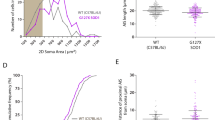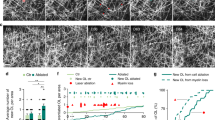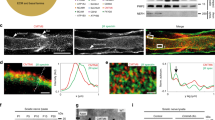Abstract
Mammalian myelinated peripheral nerve fibres display a remarkable degree of regeneration following a discrete nerve crush1. Nerve crush disrupts the axon cylinder, but leaves the basement membrane of the Schwann cell intact. These intact endoneurial tubes provide pathways to guide the regenerating axon sprouts. After contact with the periphery is established, the regenerating fibres enlarge and myelinate. Conduction velocity recovers to nearly normal and functional recovery is, in many cases, nearly complete. A distinct feature of normal mature myelinated axons is the insensitivity of these fibres to potassium channel blocking agents2–4. In contrast, immature myelinated axons are exquisitely sensitive to the K channel blocking agent 4-aminopyridine (4-AP)4,5. Application of 4-AP to immature myelinated fibres leads to a delayed membrane depolarization with action potential burst activity in response to a single stimulus5. This sensitivity to 4-AP is attenuated as the fibres mature. Previous studies4,6 have demonstrated a sensitivity to 4-AP in regenerating nerve fibres; this sensitivity differentiates the regenerating axon segments from their normal parent axon segments. Such studies have not, however, examined the question of whether regenerated fibres, which have re-established peripheral connections and are functionally active, fully recapitulate the functional organization of normal mature myelinated fibres. We demonstrate here that while sensitivity to the potassium channel blocking agents 4-AP and 3, 4-diaminopyridine (3, 4-DAP) is lost in the normal course of myelinated axon maturation, this property is present in long-term regenerated axons. This suggests that long-term regenerated mammalian axons are characterized by a functional organization that bears a closer resemblance to that of immature myelinated fibres than to that of adult myelinated fibres.
This is a preview of subscription content, access via your institution
Access options
Subscribe to this journal
Receive 51 print issues and online access
$199.00 per year
only $3.90 per issue
Buy this article
- Purchase on Springer Link
- Instant access to full article PDF
Prices may be subject to local taxes which are calculated during checkout
Similar content being viewed by others
References
Ramon Cajal. Degeneration and Regeneration of the Nervous System Vol. 1 (Oxford University Press, 1928).
Bostock, H., Sears, T. A. & Sherrattt, R. M. J. Physiol., Lond. 313, 301–315 (1981).
Kocsis, J. D. & Waxman, S. G. Nature 287, 348–349 (1980).
Ritchie, J. M. Proc. R. Soc. B215, 289–297 (1982).
Kocsis, J. D., Ruiz, J. A. & Waxman, S. G. J. Neurophysiol. (in the press).
Kocsis, J. D., Waxman, S. G., Hildebrand, C. & Ruiz, J. A. Proc. R. Soc. B217, 77–87 (1982).
Brismar, T. Acta physiol. scand. 105, 384–386 (1979).
Chiu, S. Y., Ritchie, J. M., Rogart, R. B. & Stagg, D. J. Physiol., Lond. 292, 149–166 (1979).
Chiu, S. Y. & Ritchie, J. M. J. Physiol., Lond. 313, 415–437 (1981).
Sanders, F. K. & Whitteridge, D. J. Physiol., Lond. 105, 152–174 (1946).
Cragg, B. G. & Thomas, P. K. J. Physiol., Lond. 171, 164–175 (1964).
Berthold, C. H. & Skoglund, S. Acta. soc. med. upsal. 73, 127–144 (1968).
Friede, K. & Hildebrand, C. J. Anat. Lond. 134, 517–531 (1982).
Waxman, S. G. & Foster, R. E. Proc. R. Soc. B209, 441–446 (1980).
Webster, H. deF. J. Cell Biol. 48, 348–367 (1971).
Koketsu, K. & Nishi, S. J. Physiol., Lond. 196, 293–310 (1968).
Author information
Authors and Affiliations
Rights and permissions
About this article
Cite this article
Kocsis, J., Waxman, S. Long-term regenerated nerve fibres retain sensitivity to potassium channel blocking agents. Nature 304, 640–642 (1983). https://doi.org/10.1038/304640a0
Received:
Accepted:
Issue Date:
DOI: https://doi.org/10.1038/304640a0
This article is cited by
-
Reduced cholinergic and glutamatergic synaptic input to regenerated motoneurons after facial nerve repair in rats: potential implications for recovery of motor function
Brain Structure and Function (2014)
-
Transcriptional channelopathies: An emerging class of disorders
Nature Reviews Neuroscience (2001)
-
Differential sensitivity of amphibian nodal and paranodal K+ channels to 4-aminopyridine and TEA
Experientia (1987)
Comments
By submitting a comment you agree to abide by our Terms and Community Guidelines. If you find something abusive or that does not comply with our terms or guidelines please flag it as inappropriate.



